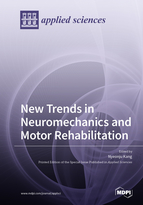New Trends in Neuromechanics and Motor Rehabilitation
A special issue of Applied Sciences (ISSN 2076-3417). This special issue belongs to the section "Applied Biosciences and Bioengineering".
Deadline for manuscript submissions: closed (15 May 2022) | Viewed by 22375
Special Issue Editor
Interests: biomechanics; motor control; neuromechanics; stroke; aging; rehabilitation; non-invasive brain stimulation; meta-analysis
Special Issues, Collections and Topics in MDPI journals
Special Issue Information
Dear Colleagues,
We are inviting manuscript submission for a Special Issue on “New Trends in Neuromechanics and Motor Rehabilitation”.
Neuromechanics has been used to identify optimal rehabilitation protocols that successfully improve motor deficits in various populations, such as elderly people and individuals with neurological diseases (e.g., stroke, Parkinson’s disease, and essential tremor). By investigating structural and functional changes in the central and peripheral nervous systems based on neuromechanical theories and findings, we can expand our knowledge regarding specific motor impairment patterns before and after therapies and underlying neurophysiological mechanisms, and further develop new training programs (e.g., non-invasive brain stimulation). Thus, the aim of this Special Issue is to gather the main contributions of researchers and rehabilitation specialists in biomechanics, motor control, neurophysiology, neuroscience, and rehabilitation science. The current collection will provide new neuromechanical approaches addressing theoretical, methodological, and practical topics for facilitating motor recovery progress. All experimental, systematic reviews, and meta-analysis studies will be welcome.
Prof. Dr. Nyeonju Kang
Guest Editor
Manuscript Submission Information
Manuscripts should be submitted online at www.mdpi.com by registering and logging in to this website. Once you are registered, click here to go to the submission form. Manuscripts can be submitted until the deadline. All submissions that pass pre-check are peer-reviewed. Accepted papers will be published continuously in the journal (as soon as accepted) and will be listed together on the special issue website. Research articles, review articles as well as short communications are invited. For planned papers, a title and short abstract (about 100 words) can be sent to the Editorial Office for announcement on this website.
Submitted manuscripts should not have been published previously, nor be under consideration for publication elsewhere (except conference proceedings papers). All manuscripts are thoroughly refereed through a single-blind peer-review process. A guide for authors and other relevant information for submission of manuscripts is available on the Instructions for Authors page. Applied Sciences is an international peer-reviewed open access semimonthly journal published by MDPI.
Please visit the Instructions for Authors page before submitting a manuscript. The Article Processing Charge (APC) for publication in this open access journal is 2400 CHF (Swiss Francs). Submitted papers should be well formatted and use good English. Authors may use MDPI's English editing service prior to publication or during author revisions.
Keywords
- Neuromechanics
- Biomechanics
- Motor control
- Motor learning
- Neurophysiology
- Exercise science
- Motor rehabilitation
- Movement training
- Electrical stimulation
- Aging
- Neurological disease
- Movement disorder
- Meta-analysis






